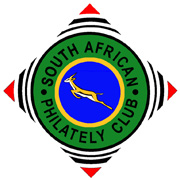Hotels of southern Africa
Quote from Steve on June 23, 2025, 1:13 pmIntroduction - Rhodesia -By-The-Sea
Circa 1960. 'Rhodesia By-The-Sea` Hotel, Simonstown. (Photo. Springbok Studios).
Hotels have had a huge influence on my life as a boy growing up in South Africa. As a child just sentient I was taken to a hotel in Somerset West where we sat outside on a raised terrace, a first for me. The air was warm and infused with the smell of the surrounding countryside's rich earth. Here I saw balls of butter scooped off a block for the first time. That magic moment lingers still.
One summer my Rhodesian cousins and their parents visited us in Pinelands and invited us to lunch with them at 'Rhodesia By-The-Sea' in Simonstown. I was young and callow. The place took my breath away. I was transported to an imaginary Africa via a spiral staircase decorated with flame lilies that ascended from the foyer to the heavens one floor above. It was exotic and enchanting, a cunningly crafted illusion, 'The African Queen' transporting 'Sammy going South to the Land of Happiness'. Whatever it was it defined central Africa for me as chic, exotic and overwhelmingly cool. At that moment I wanted more than anything to live in Rhodesia. Fortunately my father did not!
The postcard shows Rhodesia-By-The-Sea in the 1960s. Looking at this postcard it is difficult to understand just why it impressed me so much back then. The floor with large windows and pillars is the upstairs dining hall. The roof supposedly represents the sports deck of a ship. Because this building was originally built for Royal Navy officers and their families stationed in Simonstown it has many quality features. Today the protruding section of this building has been demolished and the flats (apartments) sold off to private buyers. My Rhodesian cousin bought one as a holiday home in 2000. He sold it before emigrating to Australia having predicted the paralysing rot that the ANC and their corrupt cronies would inflict on the economy with the redistribution of wealth by means other than hard work and thrift.
1963. 'Sammy Going South' was retitled 'A Boy Ten Feet Tall'.
After Sammy's parents are killed in Egyp's 'Suez Crisis' in 1956 he flees overland to an aunt in South Africa.
Chorus: 'Sammy going south, keep a going south till you reach the Land of Happiness.'
This did not chime well with the Anti-Apartheid Movement.
At the time I thought it a cracking movie despite Sammy wearing socks with sandals!Hotels hold a special place in the hearts of many South Africans who did not spend their holidays camping. The most important hotel in my development was the unpretentious Farmhouse Hotel in Ceres which was owned by my two Afrikaans aunts, Tilla Conradie and Annie Nel. I have wonderful memories of growing up in that gracious old-style South African hotel. Indeed its huge copper kettle is still in my possession. I spent most of my summer school holidays in its swimming pool. As my parents were not particularly well-off and my father was not a spendthrift we only visited a restaurant once a year and never stayed in a hotel that was not the Farm House. Those happy days in my aunts' hotel were ended by the earthquake of 29 September 1969 which struck Tulbagh, Wolseley and Ceres, even shattering plate glass windows in central Cape Town 80 miles away. By this time I was beginning to frequent the Coral Lounge in the Grand Hotel on Saturday mornings in central Cape Town, the Metropol Hotel on Long Street less so. Both these hotels had balconies which overlooked teeming streets from which you could watch Cape Town's beautiful people pass by. I also watched recorded English football at the White House Hotel on Strand Street on Tuesday nights. It had a seedy reputation. A drop-out friend of mine who drove a taxi and told hair-raising tales of Cape Town's night life called it the 'Whore House' but I never saw any of that!
So, my memories are the spur to this thread, one made possible by the tens of 1000s of overseas visitors who came to 'Sunny South Africa' and left us a trove of their postcards telling family and friends how wonderful the country and the experience was! Being the political prick that I am I usually search their PCs for references to Apartheid. Sadly, most tourists were seduced by the sunshine, the abundant food and the friendliness of the South Africans they met. If they thought much about it they kept it to themselves.
The Marine Hotel, Durban.
I thought I would start with this cover to Scotland showing the Marine Hotel in Durban in 1913. Having never spent a night in Natal I am unfamiliar with this hotel which was demolished in 1972. It was popular with overseas visitors and rich Transvalers, not the "Agh, pleez Daddy won't you take us down to Durban" southern suburbs okes. In its seventy year history, the Marine Hotel came to dominate Durban's Victoria embankment, the seafront promenade. This beautiful building was a long-standing Victorian and Edwardian structure that was to Durban what the Mount Nelson was to Cape Town. Many eminent people, including royalty, stayed there. Ultimately it was overtaken by modern developments and swamped by Durban's high-rise architecture. It had served the purposes of a bygone age and its day had come, as has much of our once wonderful eurocentric inner city architecture.
1913. Printed cover Grand Hotel Durban. DURBAN '4 MAY 13' to SCOTLAND.
This printed cover, an item of Marine Hotel stationery, was posted in Durban on '4 MAY 13'. As such it is an example of 'Interprovincial' use ie. a stamp of one colony or state used in another, in this case a Transvaal stamp used in Natal after Union and before the King's Head defintives of 1st September 1913. Previously, it was said that this period ran from 19th August 1910 to the 31st August 1913 when the first twelve stamps of the King’s Head definitives issue bought the Interprovincials to an end. However, as no covers have been found taxed between 1st June 1910 and 18th August 1912 for using colonial stamps outside of their province of origin, it appears that the Interprovincial period began on 1st June 1910. Further, the stamps of the Orange River Colony, Transvaal, Cape and Natal, (except those that had been demonetized), were valid in the Union from 31st May 1910 to 31st December 1937.
Please upload your treasured images of these hotels and others. If you can't, I will upload on your behalf.
Introduction - Rhodesia -By-The-Sea

Circa 1960. 'Rhodesia By-The-Sea` Hotel, Simonstown. (Photo. Springbok Studios).
Hotels have had a huge influence on my life as a boy growing up in South Africa. As a child just sentient I was taken to a hotel in Somerset West where we sat outside on a raised terrace, a first for me. The air was warm and infused with the smell of the surrounding countryside's rich earth. Here I saw balls of butter scooped off a block for the first time. That magic moment lingers still.
One summer my Rhodesian cousins and their parents visited us in Pinelands and invited us to lunch with them at 'Rhodesia By-The-Sea' in Simonstown. I was young and callow. The place took my breath away. I was transported to an imaginary Africa via a spiral staircase decorated with flame lilies that ascended from the foyer to the heavens one floor above. It was exotic and enchanting, a cunningly crafted illusion, 'The African Queen' transporting 'Sammy going South to the Land of Happiness'. Whatever it was it defined central Africa for me as chic, exotic and overwhelmingly cool. At that moment I wanted more than anything to live in Rhodesia. Fortunately my father did not!
The postcard shows Rhodesia-By-The-Sea in the 1960s. Looking at this postcard it is difficult to understand just why it impressed me so much back then. The floor with large windows and pillars is the upstairs dining hall. The roof supposedly represents the sports deck of a ship. Because this building was originally built for Royal Navy officers and their families stationed in Simonstown it has many quality features. Today the protruding section of this building has been demolished and the flats (apartments) sold off to private buyers. My Rhodesian cousin bought one as a holiday home in 2000. He sold it before emigrating to Australia having predicted the paralysing rot that the ANC and their corrupt cronies would inflict on the economy with the redistribution of wealth by means other than hard work and thrift.

1963. 'Sammy Going South' was retitled 'A Boy Ten Feet Tall'.
After Sammy's parents are killed in Egyp's 'Suez Crisis' in 1956 he flees overland to an aunt in South Africa.
Chorus: 'Sammy going south, keep a going south till you reach the Land of Happiness.'
This did not chime well with the Anti-Apartheid Movement.
At the time I thought it a cracking movie despite Sammy wearing socks with sandals!
Hotels hold a special place in the hearts of many South Africans who did not spend their holidays camping. The most important hotel in my development was the unpretentious Farmhouse Hotel in Ceres which was owned by my two Afrikaans aunts, Tilla Conradie and Annie Nel. I have wonderful memories of growing up in that gracious old-style South African hotel. Indeed its huge copper kettle is still in my possession. I spent most of my summer school holidays in its swimming pool. As my parents were not particularly well-off and my father was not a spendthrift we only visited a restaurant once a year and never stayed in a hotel that was not the Farm House. Those happy days in my aunts' hotel were ended by the earthquake of 29 September 1969 which struck Tulbagh, Wolseley and Ceres, even shattering plate glass windows in central Cape Town 80 miles away. By this time I was beginning to frequent the Coral Lounge in the Grand Hotel on Saturday mornings in central Cape Town, the Metropol Hotel on Long Street less so. Both these hotels had balconies which overlooked teeming streets from which you could watch Cape Town's beautiful people pass by. I also watched recorded English football at the White House Hotel on Strand Street on Tuesday nights. It had a seedy reputation. A drop-out friend of mine who drove a taxi and told hair-raising tales of Cape Town's night life called it the 'Whore House' but I never saw any of that!
So, my memories are the spur to this thread, one made possible by the tens of 1000s of overseas visitors who came to 'Sunny South Africa' and left us a trove of their postcards telling family and friends how wonderful the country and the experience was! Being the political prick that I am I usually search their PCs for references to Apartheid. Sadly, most tourists were seduced by the sunshine, the abundant food and the friendliness of the South Africans they met. If they thought much about it they kept it to themselves.
The Marine Hotel, Durban.
I thought I would start with this cover to Scotland showing the Marine Hotel in Durban in 1913. Having never spent a night in Natal I am unfamiliar with this hotel which was demolished in 1972. It was popular with overseas visitors and rich Transvalers, not the "Agh, pleez Daddy won't you take us down to Durban" southern suburbs okes. In its seventy year history, the Marine Hotel came to dominate Durban's Victoria embankment, the seafront promenade. This beautiful building was a long-standing Victorian and Edwardian structure that was to Durban what the Mount Nelson was to Cape Town. Many eminent people, including royalty, stayed there. Ultimately it was overtaken by modern developments and swamped by Durban's high-rise architecture. It had served the purposes of a bygone age and its day had come, as has much of our once wonderful eurocentric inner city architecture.

1913. Printed cover Grand Hotel Durban. DURBAN '4 MAY 13' to SCOTLAND.
This printed cover, an item of Marine Hotel stationery, was posted in Durban on '4 MAY 13'. As such it is an example of 'Interprovincial' use ie. a stamp of one colony or state used in another, in this case a Transvaal stamp used in Natal after Union and before the King's Head defintives of 1st September 1913. Previously, it was said that this period ran from 19th August 1910 to the 31st August 1913 when the first twelve stamps of the King’s Head definitives issue bought the Interprovincials to an end. However, as no covers have been found taxed between 1st June 1910 and 18th August 1912 for using colonial stamps outside of their province of origin, it appears that the Interprovincial period began on 1st June 1910. Further, the stamps of the Orange River Colony, Transvaal, Cape and Natal, (except those that had been demonetized), were valid in the Union from 31st May 1910 to 31st December 1937.
Please upload your treasured images of these hotels and others. If you can't, I will upload on your behalf.
Quote from Steve on July 4, 2025, 10:23 amPrince's Hotel, Newlands, Cape.
I bought this cover recently in St Ives from the Rhodesian dealer Charlie Rudge. It bears a printed photo of Prince's Hotel, Newlands, Cape Town. This may be the only surviving image to show the hotel outside of some dusty old holiday snaps hidden in a box somewhere.
Prince's Hotel was built as a private residence on the corner of Protea Road and Main Road, Newlands. Known as 'The Retreat', the house was converted into a small 20-bed hotel in 1927. It is included in the Union-Castle Lines 'Year Book and Guide to Southern Africa 1956' under 'Newlands Hotels - Vineyard, Prince's, Cecil'. It closed in the mid-1960s when it was demolished in order that the Stellenberg block of flats be built on the site. Other than that there is little to glean. The Cape Town postmark is a little curious.
1934. Printed cover. CAPE TOWN '13 JUN 34' to BERLIN ' 26 6 34'.
The 1932 1/- brown and prussian blue stamp has been cancelled with CAPE TOWN KAAPSTAD 91 shown below.
Prince's Hotel, Newlands, Cape.
I bought this cover recently in St Ives from the Rhodesian dealer Charlie Rudge. It bears a printed photo of Prince's Hotel, Newlands, Cape Town. This may be the only surviving image to show the hotel outside of some dusty old holiday snaps hidden in a box somewhere.
Prince's Hotel was built as a private residence on the corner of Protea Road and Main Road, Newlands. Known as 'The Retreat', the house was converted into a small 20-bed hotel in 1927. It is included in the Union-Castle Lines 'Year Book and Guide to Southern Africa 1956' under 'Newlands Hotels - Vineyard, Prince's, Cecil'. It closed in the mid-1960s when it was demolished in order that the Stellenberg block of flats be built on the site. Other than that there is little to glean. The Cape Town postmark is a little curious.

1934. Printed cover. CAPE TOWN '13 JUN 34' to BERLIN ' 26 6 34'.
The 1932 1/- brown and prussian blue stamp has been cancelled with CAPE TOWN KAAPSTAD 91 shown below.

Quote from Steve on July 4, 2025, 10:59 amCentral Hotel, Dordrecht, Cape.
1937. Printed cover. TARKASTAD '17 MAY 37' to AUSTRALIA.
Tarkastad lies some 85 miles (138 km) from Dordrecht. Presumably the person who posted this cover had stayed at the Central Hotel in Dordrecht where they obtained some items of hotel stationery that included this cover. The letter was either written in Dordrecht or Tarkastand. The cancellation suggests that it was posted in Tarkastad on the arrival of the writer. Sadly, not a great postmark.
The Union-Castle Lines 'Year Book and Guide to Southern Africa 1956' tells us that Dordrecht had two hotels, the Masonic and the 'Central 15s', (presumably the cost of an overnight stay). 'Buses meet trains on request'. So, not a lot of people getting off there then!
Central Hotel, Dordrecht, Cape.

1937. Printed cover. TARKASTAD '17 MAY 37' to AUSTRALIA.
Tarkastad lies some 85 miles (138 km) from Dordrecht. Presumably the person who posted this cover had stayed at the Central Hotel in Dordrecht where they obtained some items of hotel stationery that included this cover. The letter was either written in Dordrecht or Tarkastand. The cancellation suggests that it was posted in Tarkastad on the arrival of the writer. Sadly, not a great postmark.
The Union-Castle Lines 'Year Book and Guide to Southern Africa 1956' tells us that Dordrecht had two hotels, the Masonic and the 'Central 15s', (presumably the cost of an overnight stay). 'Buses meet trains on request'. So, not a lot of people getting off there then!
Quote from Steve on July 5, 2025, 2:54 pmHexagon Hotel, Queenstown, Cape. (Today 'Komani'.)
During WW2,Queenstown had a major as part of the Commonwealth Air Training Plan RAF base. The printed cover below from the Hexagon Hotel shows the RAF cachet of AFS Queenstown. The aerial view of the town was taken during a RAF photographic training flight. The postcard shows a view of the Hexagon on the ground. Sadly, there is no view of the Hexagon Hotel which is presumably nearby.
Circa 1943. Queenstown (Komani) from the air showing the defensive nature of the Hexagon. (Photo ex-RAF.)
The Hexagon Hotel is presumably one of the buildings fronting onto the centre of the Hexagon. (Last line of defence!)
1941. Printed cover. AFS QUEENSTOWN '15-12-1941' to EAST LONDON.
Circa 1945. Postcard. 'The Hexagon, Queenstown.' (Photo: SAR.) Unused.
Hexagon Hotel, Queenstown, Cape. (Today 'Komani'.)
During WW2,Queenstown had a major as part of the Commonwealth Air Training Plan RAF base. The printed cover below from the Hexagon Hotel shows the RAF cachet of AFS Queenstown. The aerial view of the town was taken during a RAF photographic training flight. The postcard shows a view of the Hexagon on the ground. Sadly, there is no view of the Hexagon Hotel which is presumably nearby.

Circa 1943. Queenstown (Komani) from the air showing the defensive nature of the Hexagon. (Photo ex-RAF.)
The Hexagon Hotel is presumably one of the buildings fronting onto the centre of the Hexagon. (Last line of defence!)

1941. Printed cover. AFS QUEENSTOWN '15-12-1941' to EAST LONDON.

Circa 1945. Postcard. 'The Hexagon, Queenstown.' (Photo: SAR.) Unused.
Quote from Steve on July 5, 2025, 3:13 pmQueen's Hotel, Sea Point.
When Malcolm Campbell came to South Africa in February 1929 with the aim of breaking the world land speed record at Verneukpan he bought his family with him. They stayed at the Queen's Hotel, Sea Point which became his headquarters while in Cape Town. Our thanks to Bob Hill for supplying this page from his wonderful 'Malcolm Campbell in SA' collection.
Queen's Hotel, Sea Point.
When Malcolm Campbell came to South Africa in February 1929 with the aim of breaking the world land speed record at Verneukpan he bought his family with him. They stayed at the Queen's Hotel, Sea Point which became his headquarters while in Cape Town. Our thanks to Bob Hill for supplying this page from his wonderful 'Malcolm Campbell in SA' collection.

Quote from Steve on July 6, 2025, 4:40 pmGrand Hotel, Cape Town.
I have previously written about my memories of the Grand Hotel, Cape Town.
Circa 1912. Postcard. The Grand Hotel, Cape Town. Unused.
1900. The Grand Hotel, Cape Town. See the link above for a full description.
Note the similarity of the Grand Hotel, Cape Town' s stationery design above with that of Pretoria below.
1904. Postcard. The Grand Hotel, Cape Town. (T. D. Ravenscroft, Rondebosch.)
Dating difficult. The stamp / cancellation date has been removed. No cars visible.
An interestining view of the Grand Hotel with plants on balcony as per the printed letterGrand Hotel, Pretoria.
Prior to buying the cover below I was blissfully unaware about the existence of a 'Grand Hotel' in Pretoria. For me, there was only one Grand Hotel in SA and that was the one in Cape Town on the corner of Strand and Adderley Streets close to the harbour and more or less opposite Cape Town Railway Station. It was buily in 1894, four years after the President Hotel, later the Grand Hotel, Pretoria.
1900. Printed cover. Grand Hotel Pretoria. PRETORIA ZAR '19 JUL 00' to READING, GB 'AU 11 00'.
Pretoria fell to the British on 5th June 1900. All ZAR stamps were proclaimed invalid on 18 June 1900.
Only Stamps overprinted 'V.R.I.'by the British were recognised as valid for the payment of postage.
However, the old ZAR datestamps would continue to be used, in some cases until the end of 1900.
This cover has been overpaiod by 1d postage (should be 2½d postage + 4d Registration).The Grand Hotel was located on the south-eastern corner of Church Square. The Old Raadsaal was built next to the Grand Hotel at the same time. The hotel was built in 1890 by Mrs Lys who named it the President Hotel. It could accommodate 70 visitors and had 30 white servants and 23 coloured attendants. In 1892 the proprietor was H. W. F. Burger.
In 1895 it was renamed the Grand Hotel with a Mr S. Schlomer as proprietor. Perhaps in the context of the politics of the time the name 'President' did not convey quite the same attributes as 'Grand' to visiting Uitlanders. Itsproud republican publicity still echoes in its claim to be "one of the finest hotels in South Africa, comparing very favourably with its European contemporaries".
When President Paul Kruger was informed that the new hotel would be taller than Raadsaal, his new government building on Church Square, he insisted that the two-storey Raadsaal be given an extra third floor. Kruger had his way. The balconies of the Grand Hotel were a famous vantage point for grand events of the period, like the inauguration of President Kruger and presumably also the occupation of Pretoria by Lord Roberts on 5th June 1900.
The Grand Hotel Pretoria's architect was Wilhelm (Wim) Johannes De Zwaan. I do not know when it was demolished. Today the "neoclassical" Standard Bank building stands on the site of the old Grand Hotel. The postcard belows shows in about 1909.
Circa 1909. Grand Hotel Pretoria (Transvaal). (Published by Hallis & Co., Port Elizabeth.)
Postcards. PRETORIA '08 FEB 09' to GB.This is an AI (ChatGPT) colourised view of the same postcard.
To see how to colourise your Black and White postcards, click here.
The fact that Hallis & Co., a distant Cape postcard company, chose to publish this suggests the Grand Hotel was something special.
Grand Hotel, Cape Town.
I have previously written about my memories of the Grand Hotel, Cape Town.
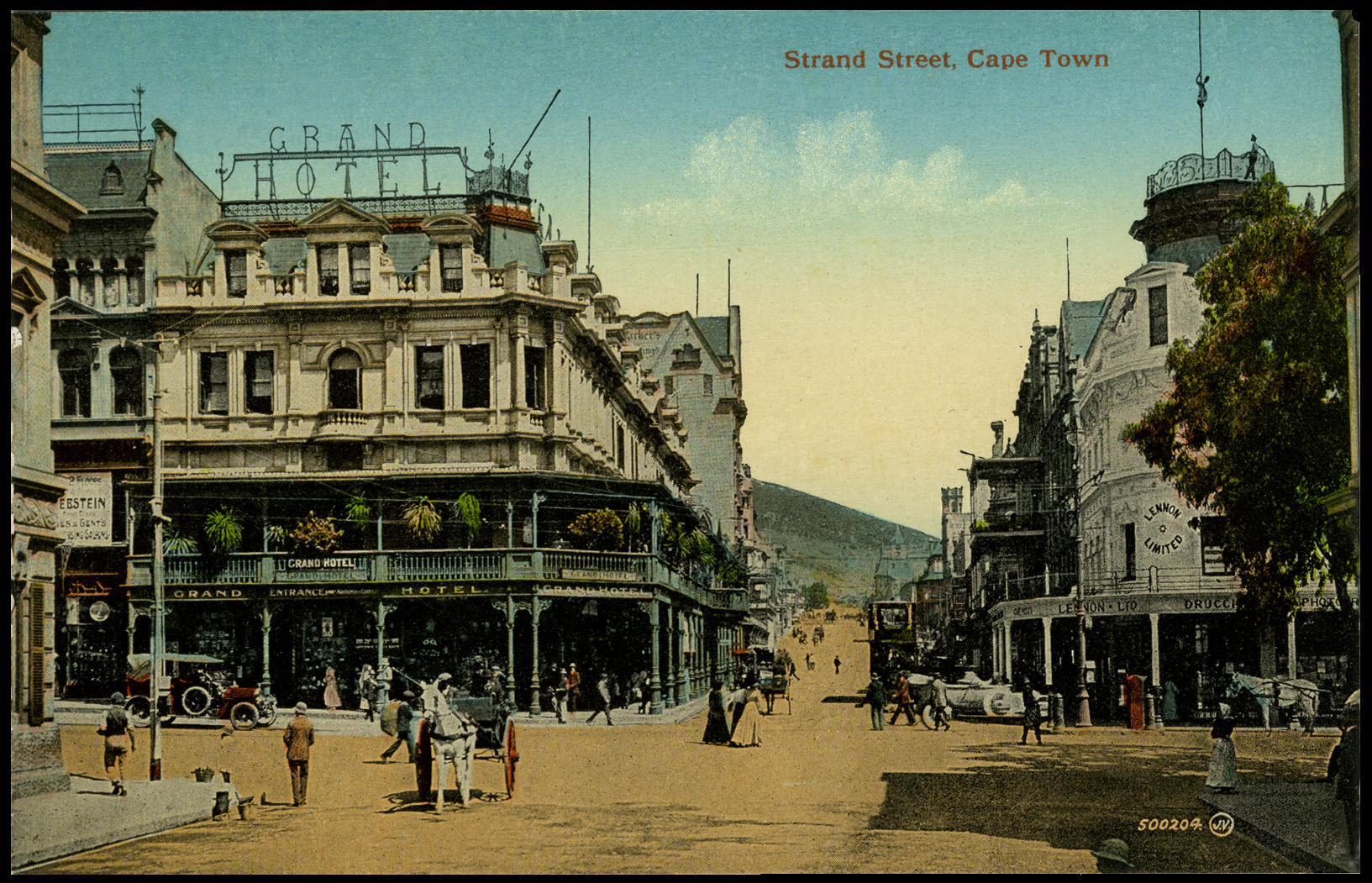
Circa 1912. Postcard. The Grand Hotel, Cape Town. Unused.

1900. The Grand Hotel, Cape Town. See the link above for a full description.
Note the similarity of the Grand Hotel, Cape Town' s stationery design above with that of Pretoria below.
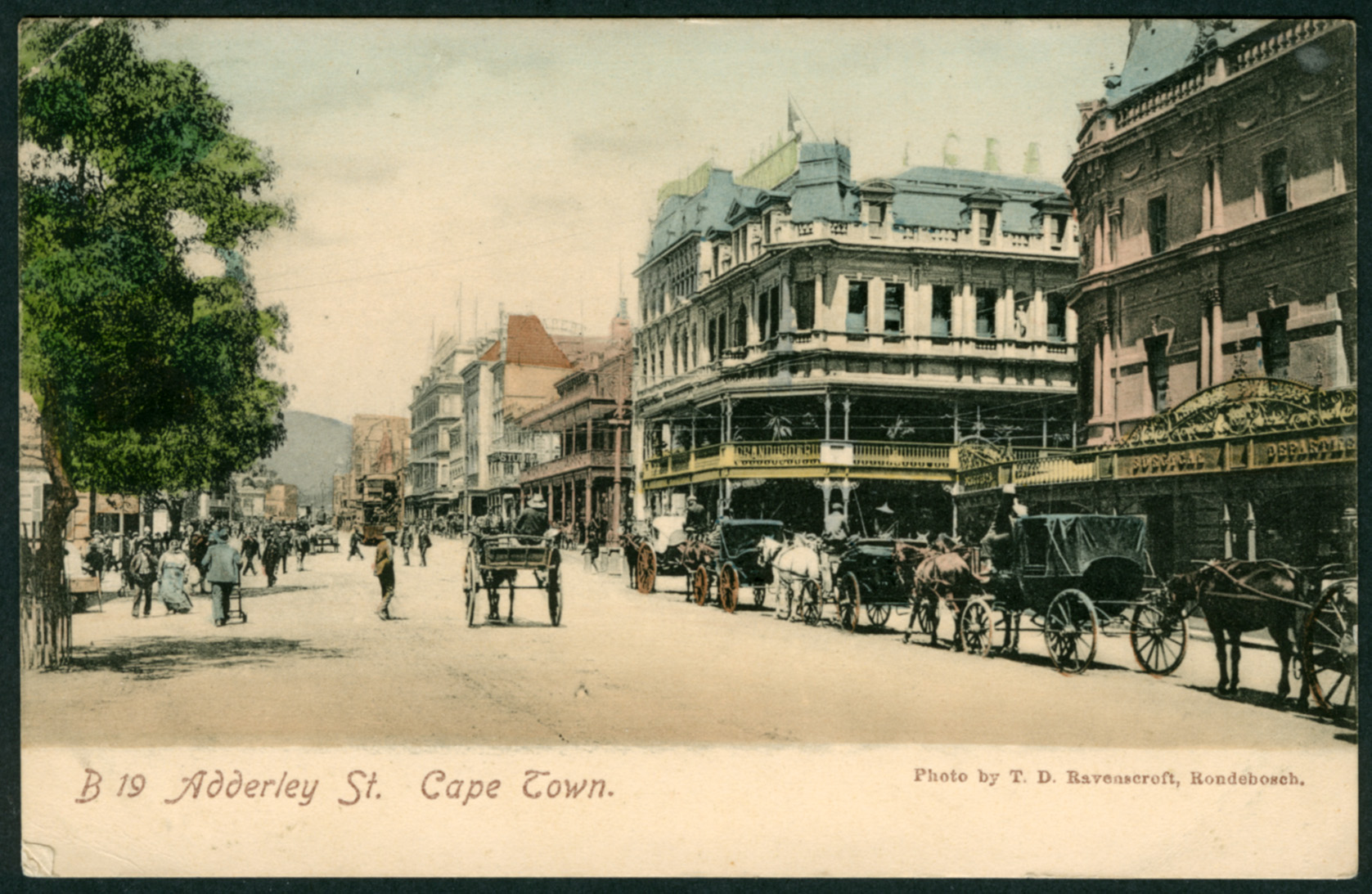
1904. Postcard. The Grand Hotel, Cape Town. (T. D. Ravenscroft, Rondebosch.)
Dating difficult. The stamp / cancellation date has been removed. No cars visible.
An interestining view of the Grand Hotel with plants on balcony as per the printed letter
Grand Hotel, Pretoria.
Prior to buying the cover below I was blissfully unaware about the existence of a 'Grand Hotel' in Pretoria. For me, there was only one Grand Hotel in SA and that was the one in Cape Town on the corner of Strand and Adderley Streets close to the harbour and more or less opposite Cape Town Railway Station. It was buily in 1894, four years after the President Hotel, later the Grand Hotel, Pretoria.

1900. Printed cover. Grand Hotel Pretoria. PRETORIA ZAR '19 JUL 00' to READING, GB 'AU 11 00'.
Pretoria fell to the British on 5th June 1900. All ZAR stamps were proclaimed invalid on 18 June 1900.
Only Stamps overprinted 'V.R.I.'by the British were recognised as valid for the payment of postage.
However, the old ZAR datestamps would continue to be used, in some cases until the end of 1900.
This cover has been overpaiod by 1d postage (should be 2½d postage + 4d Registration).
The Grand Hotel was located on the south-eastern corner of Church Square. The Old Raadsaal was built next to the Grand Hotel at the same time. The hotel was built in 1890 by Mrs Lys who named it the President Hotel. It could accommodate 70 visitors and had 30 white servants and 23 coloured attendants. In 1892 the proprietor was H. W. F. Burger.
In 1895 it was renamed the Grand Hotel with a Mr S. Schlomer as proprietor. Perhaps in the context of the politics of the time the name 'President' did not convey quite the same attributes as 'Grand' to visiting Uitlanders. Itsproud republican publicity still echoes in its claim to be "one of the finest hotels in South Africa, comparing very favourably with its European contemporaries".
When President Paul Kruger was informed that the new hotel would be taller than Raadsaal, his new government building on Church Square, he insisted that the two-storey Raadsaal be given an extra third floor. Kruger had his way. The balconies of the Grand Hotel were a famous vantage point for grand events of the period, like the inauguration of President Kruger and presumably also the occupation of Pretoria by Lord Roberts on 5th June 1900.
The Grand Hotel Pretoria's architect was Wilhelm (Wim) Johannes De Zwaan. I do not know when it was demolished. Today the "neoclassical" Standard Bank building stands on the site of the old Grand Hotel. The postcard belows shows in about 1909.
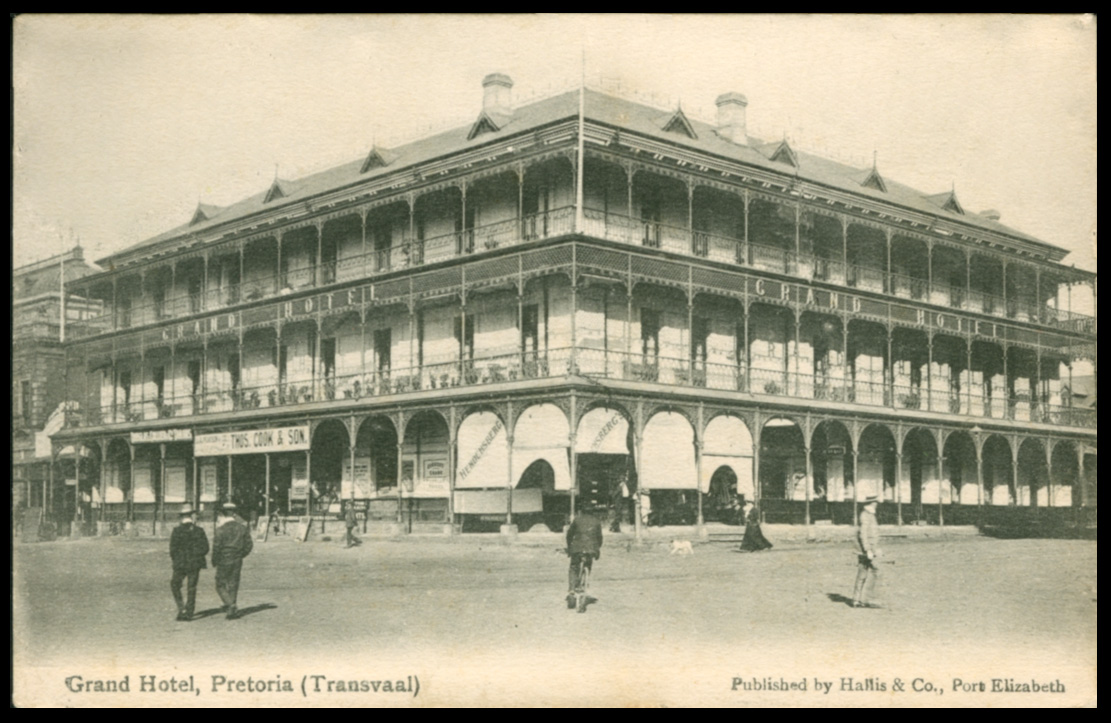
Circa 1909. Grand Hotel Pretoria (Transvaal). (Published by Hallis & Co., Port Elizabeth.)
Postcards. PRETORIA '08 FEB 09' to GB.
This is an AI (ChatGPT) colourised view of the same postcard.
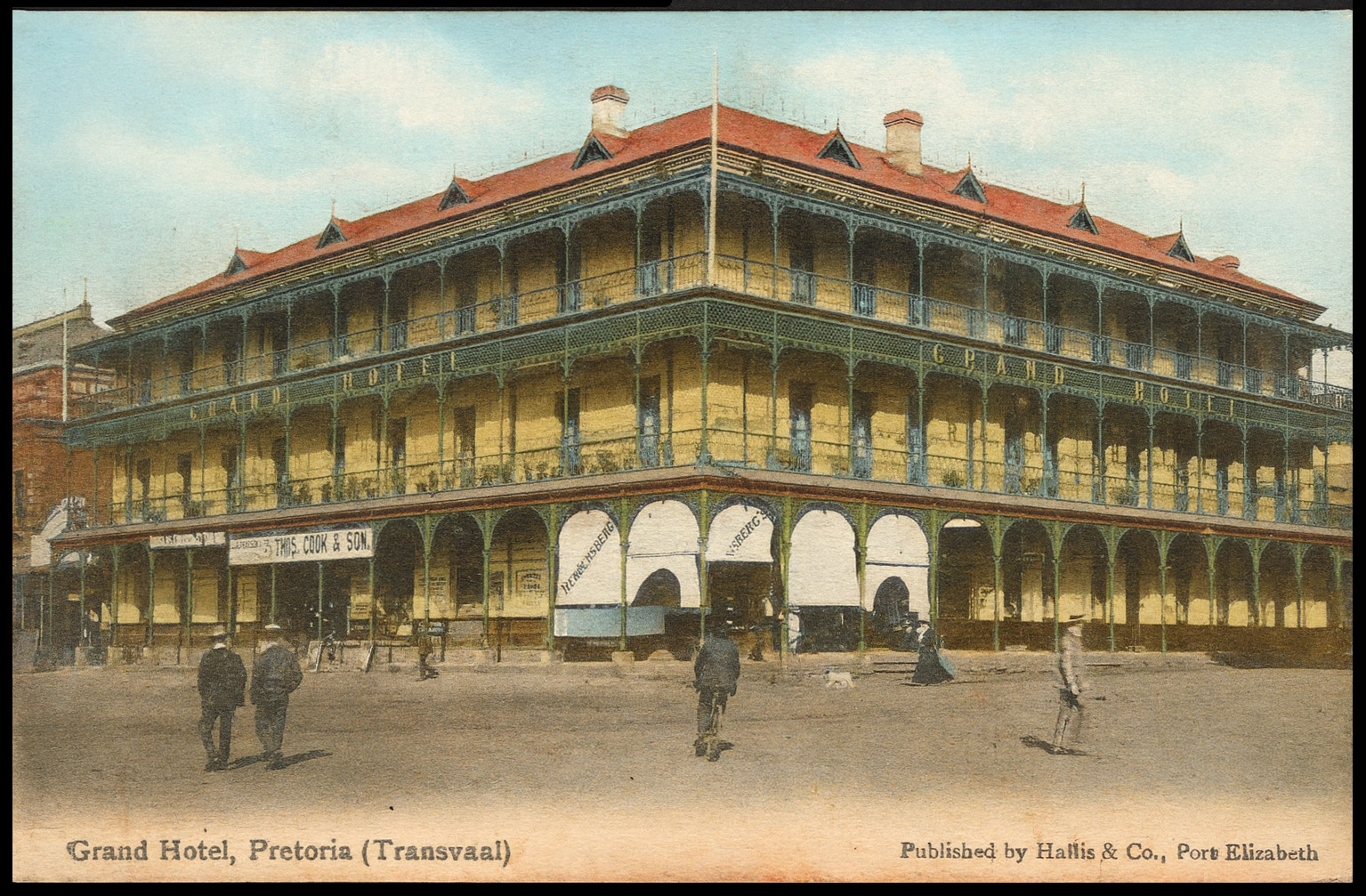
To see how to colourise your Black and White postcards, click here.
The fact that Hallis & Co., a distant Cape postcard company, chose to publish this suggests the Grand Hotel was something special.
Quote from Steve on July 20, 2025, 12:54 pmCosmopolitan Hotel, Simonstown
I visited the Long Melford, Suffolk, Book Fair (with Postcards, Ephemera and Cigarette Cards) this last weekend. The trip also gave my wife and I the opportunity to lunch at The Greyhound in Lavenham, an old wool town with an abundance of heritage architecture and a to browse an interesting if over-priced antique shop where we have never bought anything. It is conveniently close to Sudbury where we spent the afternoon walking water meadows beloved of Thomas Gainsborough, the English portrait and landscape painter born there in 1727. The card below was on sale in Long Melford. The dealer I bought it from had other nice but expensive items which I did not buy.
The Cosmopolitan Hotel on Queen's Road was owned by Ohlsson`s Cape Brewery from 1887 until 1956. Ohlsson's was a South African brewing company located in Newlands, Cape Town founded around 1881 by a Swedish immigrant and industrialist, Anders Ohlsson. The brewery drew water from the Albion Springs, Newlands. Ohlsson's was bought out by Castle Breweries in 1956 and merged to form South African Breweries. After the Cosmopolitan's rebuilding in 1966 it was briefly known as the Metropole Hotel. As the gimmicky marleting 'Free Pass' below shows the drinking of beer, apparently the preferred tipple of the English, was encouraged by the hotel's owners. In the 1950s the Nat government would tax beer disproportionately. The Nats did this in support of brandy and wine, the product of vineyards ownned by their wealthy supporters in the Western Cape's politically powerful Afrikaans-speaking farming community.
The card above is not a postcard. It is a sales tool, a marketing gimmick intended to increase awareness of the Cosmopolitan Hotel, presumably as a place to stay but most especially to drink at! There is no space for a stamp, message or address. Postal history displays benefit from the inclusion of fun items like this. It is also an interesting item of Cape social history. The chauffeur of the impressive motor car in the foreground, CA 5520, appears to be a Coloured or Black man. This was a time when many prejudiced White South Africans could not drive. Which was perhaps a good thing because they were certainlt being encouraged to drink!
Cosmopolitan Hotel, Simonstown
I visited the Long Melford, Suffolk, Book Fair (with Postcards, Ephemera and Cigarette Cards) this last weekend. The trip also gave my wife and I the opportunity to lunch at The Greyhound in Lavenham, an old wool town with an abundance of heritage architecture and a to browse an interesting if over-priced antique shop where we have never bought anything. It is conveniently close to Sudbury where we spent the afternoon walking water meadows beloved of Thomas Gainsborough, the English portrait and landscape painter born there in 1727. The card below was on sale in Long Melford. The dealer I bought it from had other nice but expensive items which I did not buy.
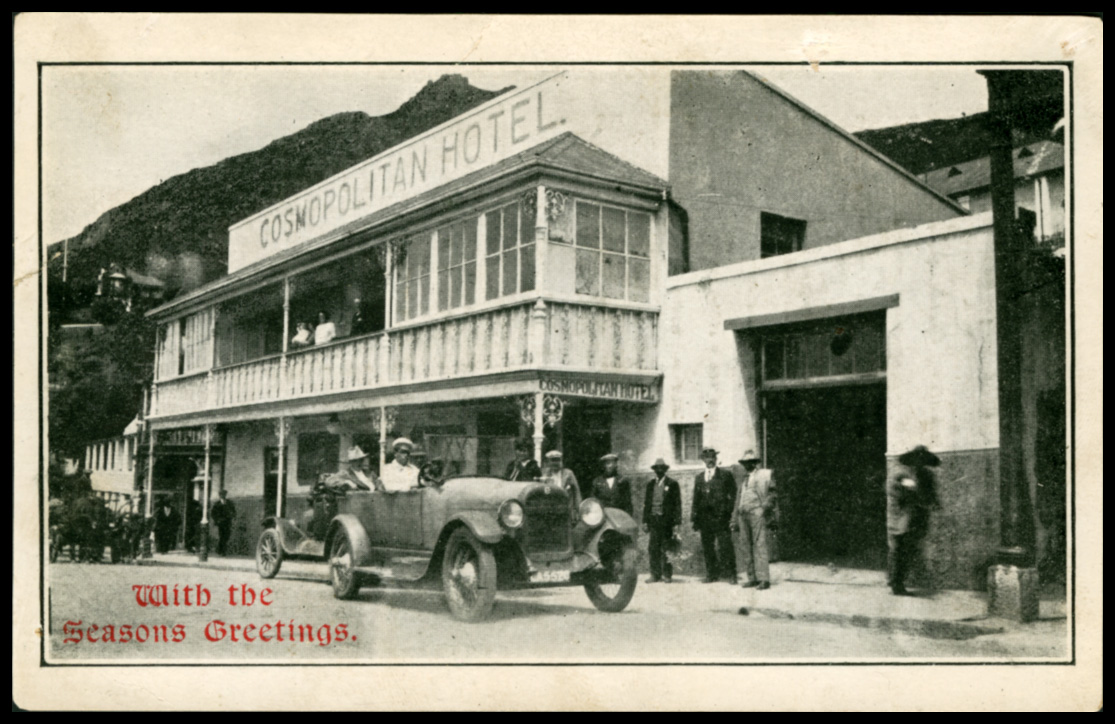
The Cosmopolitan Hotel on Queen's Road was owned by Ohlsson`s Cape Brewery from 1887 until 1956. Ohlsson's was a South African brewing company located in Newlands, Cape Town founded around 1881 by a Swedish immigrant and industrialist, Anders Ohlsson. The brewery drew water from the Albion Springs, Newlands. Ohlsson's was bought out by Castle Breweries in 1956 and merged to form South African Breweries. After the Cosmopolitan's rebuilding in 1966 it was briefly known as the Metropole Hotel. As the gimmicky marleting 'Free Pass' below shows the drinking of beer, apparently the preferred tipple of the English, was encouraged by the hotel's owners. In the 1950s the Nat government would tax beer disproportionately. The Nats did this in support of brandy and wine, the product of vineyards ownned by their wealthy supporters in the Western Cape's politically powerful Afrikaans-speaking farming community.
The card above is not a postcard. It is a sales tool, a marketing gimmick intended to increase awareness of the Cosmopolitan Hotel, presumably as a place to stay but most especially to drink at! There is no space for a stamp, message or address. Postal history displays benefit from the inclusion of fun items like this. It is also an interesting item of Cape social history. The chauffeur of the impressive motor car in the foreground, CA 5520, appears to be a Coloured or Black man. This was a time when many prejudiced White South Africans could not drive. Which was perhaps a good thing because they were certainlt being encouraged to drink!
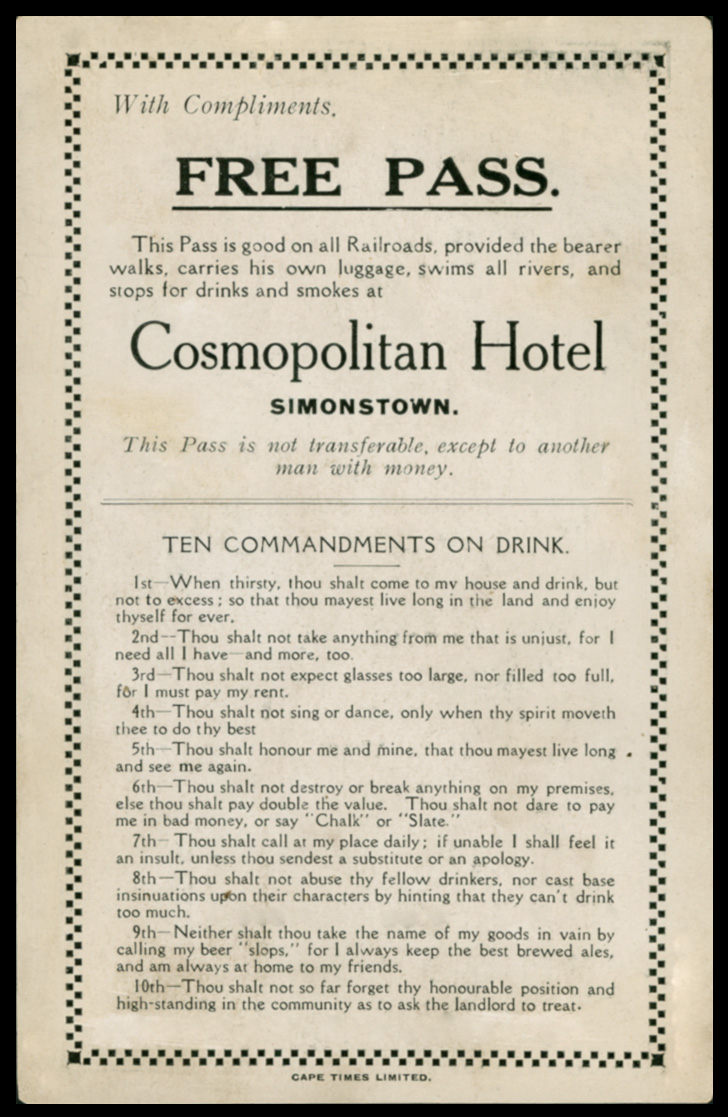
Quote from Steve on July 21, 2025, 10:52 amAvalon Hotel, Montagu
This hotel is a mystery. A quick Google search finds little specific. Anything there is details Montagu's myriad of modern hotels and spas and the Avalon Spring from which this hotel takes its name. The 1956 Union-Castle Line's 'Year Book and Guide to Southern Africa' lists the Hotel Avalon, 'six miles from Ashton'. Presumably it refers to the monstrous construct shown below, possibly a Sanitorium. As the Hotel Avalon is not listed in Bob Hill's 1952 Union-Castle Year Book I assume it was built between 1952 - 1956.
1967. Postcard. MONTAGU '5 IX 67' to GB. (De Jong-Typo 439/B).
According to the 1956 Year Book, Montagu was "officially declared a Health and Pleasure Resort in 1936. .... Montagu is visited by many tourists and invalids. .... Montage Hot Baths and Sanatorium are two miles beyond the village in a beautiful Kloof. .... The hotel is placed over the springs, which rise near the head of a most picturesque Kloof at a temperature of 112.3 degrees Fahr. Used from time immemorial by the natives, the medicinal properties of the water have been known for over 200 years. A swimming bath has been provided, also golf links, tennis lawns, etc." (The "natives", the indigenous people, were not given access to the baths during this era of segregation. Those who defended Apartheid at this time often asked "would you want Blacks in your swimming pool?")
There are many hot water springs in the Western Cape, parts of which sits on an ancient caldera, like Warmwaterberg in the Little Karoo. The Kloof referred to here is Kogmanskloof, a gorge named after a Khoi chiefdom that existed in the Montagu area in the early 18th century before they were devastated by smallpox. Ashton lies at the southern end of Kogmanskloof. In January 1981, torrential downpours in the southern Karoo caused the Keisie and Kigna rivers to flood and meet at their confluence in Montagu before rushing through Cogmanskloof to Ashton and the Breede River. There was "considerable loss of life and damage to property". This hotel was possibly destroyed. It appears to no longer exist. I am keen to learn more about these events. Please advise if you can fill in the gaps.
Avalon Hotel, Montagu
This hotel is a mystery. A quick Google search finds little specific. Anything there is details Montagu's myriad of modern hotels and spas and the Avalon Spring from which this hotel takes its name. The 1956 Union-Castle Line's 'Year Book and Guide to Southern Africa' lists the Hotel Avalon, 'six miles from Ashton'. Presumably it refers to the monstrous construct shown below, possibly a Sanitorium. As the Hotel Avalon is not listed in Bob Hill's 1952 Union-Castle Year Book I assume it was built between 1952 - 1956.
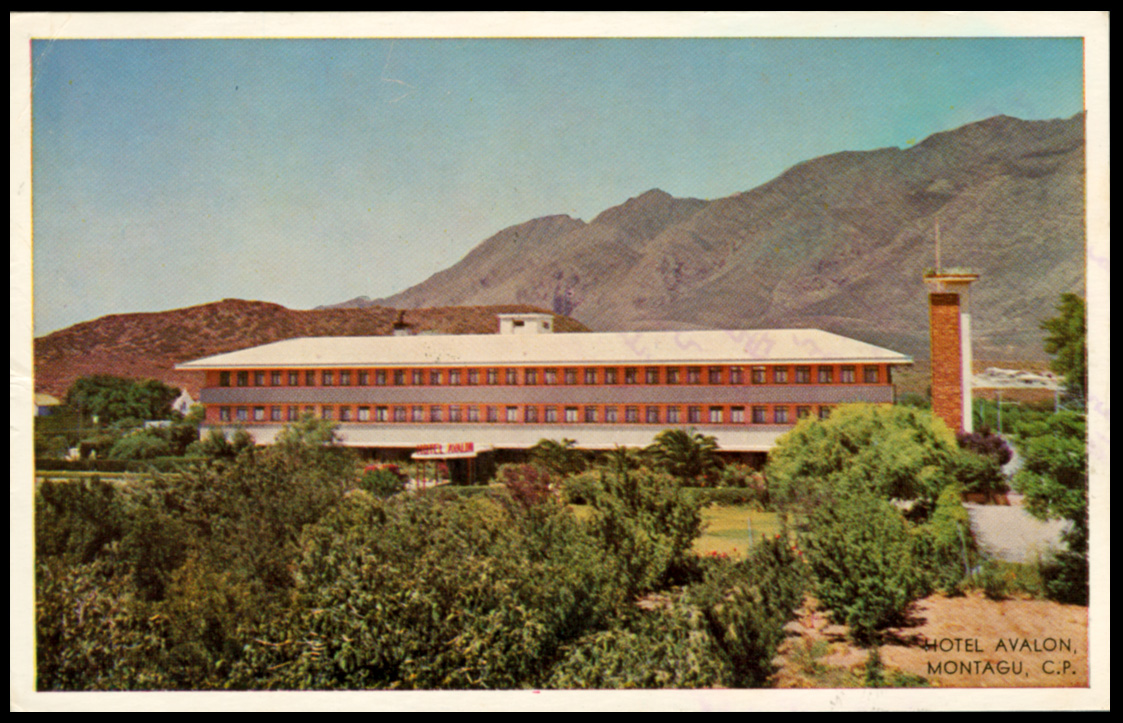
1967. Postcard. MONTAGU '5 IX 67' to GB. (De Jong-Typo 439/B).
According to the 1956 Year Book, Montagu was "officially declared a Health and Pleasure Resort in 1936. .... Montagu is visited by many tourists and invalids. .... Montage Hot Baths and Sanatorium are two miles beyond the village in a beautiful Kloof. .... The hotel is placed over the springs, which rise near the head of a most picturesque Kloof at a temperature of 112.3 degrees Fahr. Used from time immemorial by the natives, the medicinal properties of the water have been known for over 200 years. A swimming bath has been provided, also golf links, tennis lawns, etc." (The "natives", the indigenous people, were not given access to the baths during this era of segregation. Those who defended Apartheid at this time often asked "would you want Blacks in your swimming pool?")
There are many hot water springs in the Western Cape, parts of which sits on an ancient caldera, like Warmwaterberg in the Little Karoo. The Kloof referred to here is Kogmanskloof, a gorge named after a Khoi chiefdom that existed in the Montagu area in the early 18th century before they were devastated by smallpox. Ashton lies at the southern end of Kogmanskloof. In January 1981, torrential downpours in the southern Karoo caused the Keisie and Kigna rivers to flood and meet at their confluence in Montagu before rushing through Cogmanskloof to Ashton and the Breede River. There was "considerable loss of life and damage to property". This hotel was possibly destroyed. It appears to no longer exist. I am keen to learn more about these events. Please advise if you can fill in the gaps.
Quote from Steve on July 21, 2025, 12:41 pmCaledon Thermal Chalybeate Springs, Baths and Sanatorium
Sticking with the Western Cape's hot springs, this item is from Caledon's long-serving spa. Thermal springs are a feature of the Western Cape and are not uncommon. The distance between Montagu and Caledon is approximately 147 km or 91 miles. The distance between Montagu and Warmwaterberg is approximately 91 km or 57 miles. Over many years the natural thermal springs at Goudini Spa, Montagu and Caledon have been developed into large commercial leisure resorts. The Caledon Spa is probably the most well-known.
1907. Cover. CALEDON 'JA 08 07' to SOMERSET WEST STRAND.
According to the publicity material of the Caledon Spa and Casino, the current owners of this natural resource, "the Caledon Resort is home to one of the Western Cape’s famous Mineral Rich Warm Spring. (sic) The hot spring originates by the emergence of geothermally heated groundwater that rises from the Earth’s crust. It produces over a million litres of water daily with an average temperature of 65 degrees Celsius. No chemicals are added and the distinctive brown colour of the water is due to the high iron content, known as chalybeate."
1907. Postcard. NAPIER 'DE 26 07' to LEICESTER, GB 'JA XX 08'. (Caledon Baths and Sanitorium - Back View).
This postcard was presumably supplied by the Proprietors of the Sanitorium.
It is an impressive complex for its time given the rural backwater that it exists in.
"I suppose you have often heard of the baths at Caldon. It is a lovely building!"This postcard was written on Boxing Day 1907 and posted on the same day in Napier. As there was no railway line connecting Caledon to Napier in 1907, it is likely that the writer was holidaying in Napier some 35 km from Caledon, presumably too far for a round day trip in a horse and cart, one of which can be seen in the postcard above.
Caledon Thermal Chalybeate Springs, Baths and Sanatorium
Sticking with the Western Cape's hot springs, this item is from Caledon's long-serving spa. Thermal springs are a feature of the Western Cape and are not uncommon. The distance between Montagu and Caledon is approximately 147 km or 91 miles. The distance between Montagu and Warmwaterberg is approximately 91 km or 57 miles. Over many years the natural thermal springs at Goudini Spa, Montagu and Caledon have been developed into large commercial leisure resorts. The Caledon Spa is probably the most well-known.
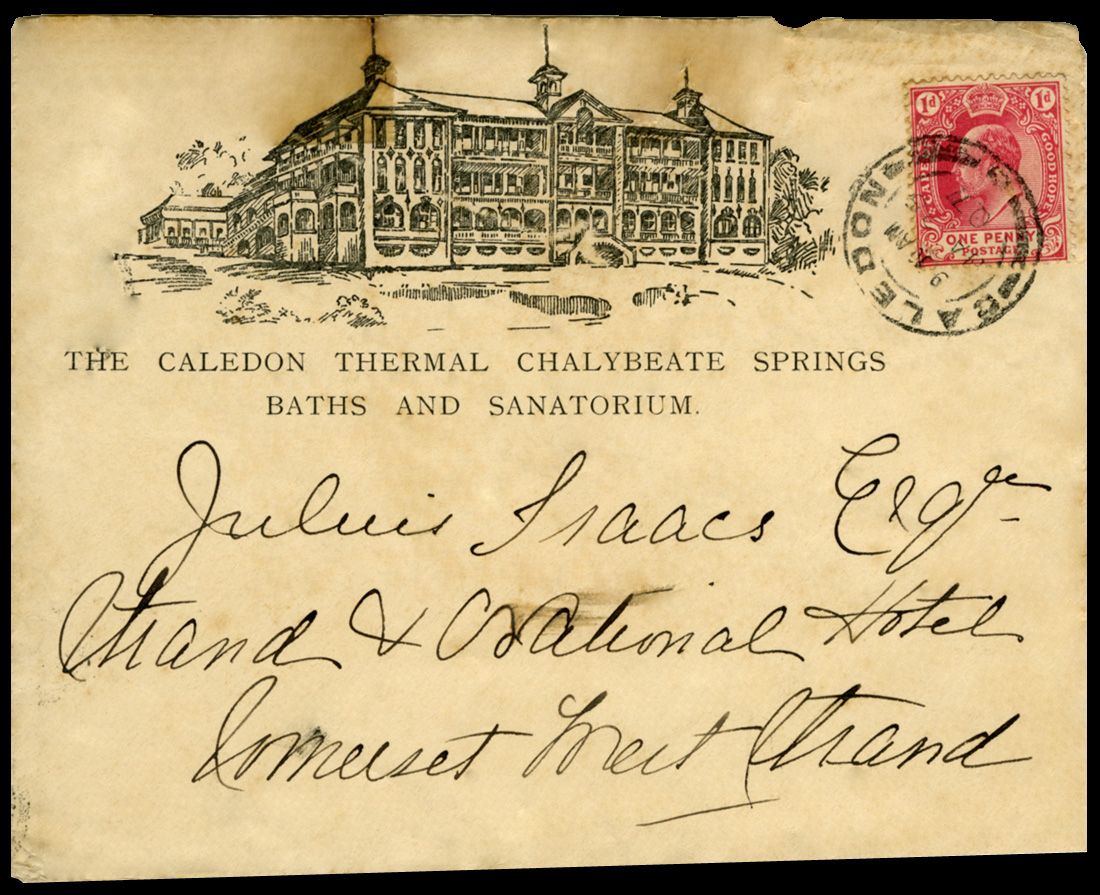
1907. Cover. CALEDON 'JA 08 07' to SOMERSET WEST STRAND.
According to the publicity material of the Caledon Spa and Casino, the current owners of this natural resource, "the Caledon Resort is home to one of the Western Cape’s famous Mineral Rich Warm Spring. (sic) The hot spring originates by the emergence of geothermally heated groundwater that rises from the Earth’s crust. It produces over a million litres of water daily with an average temperature of 65 degrees Celsius. No chemicals are added and the distinctive brown colour of the water is due to the high iron content, known as chalybeate."
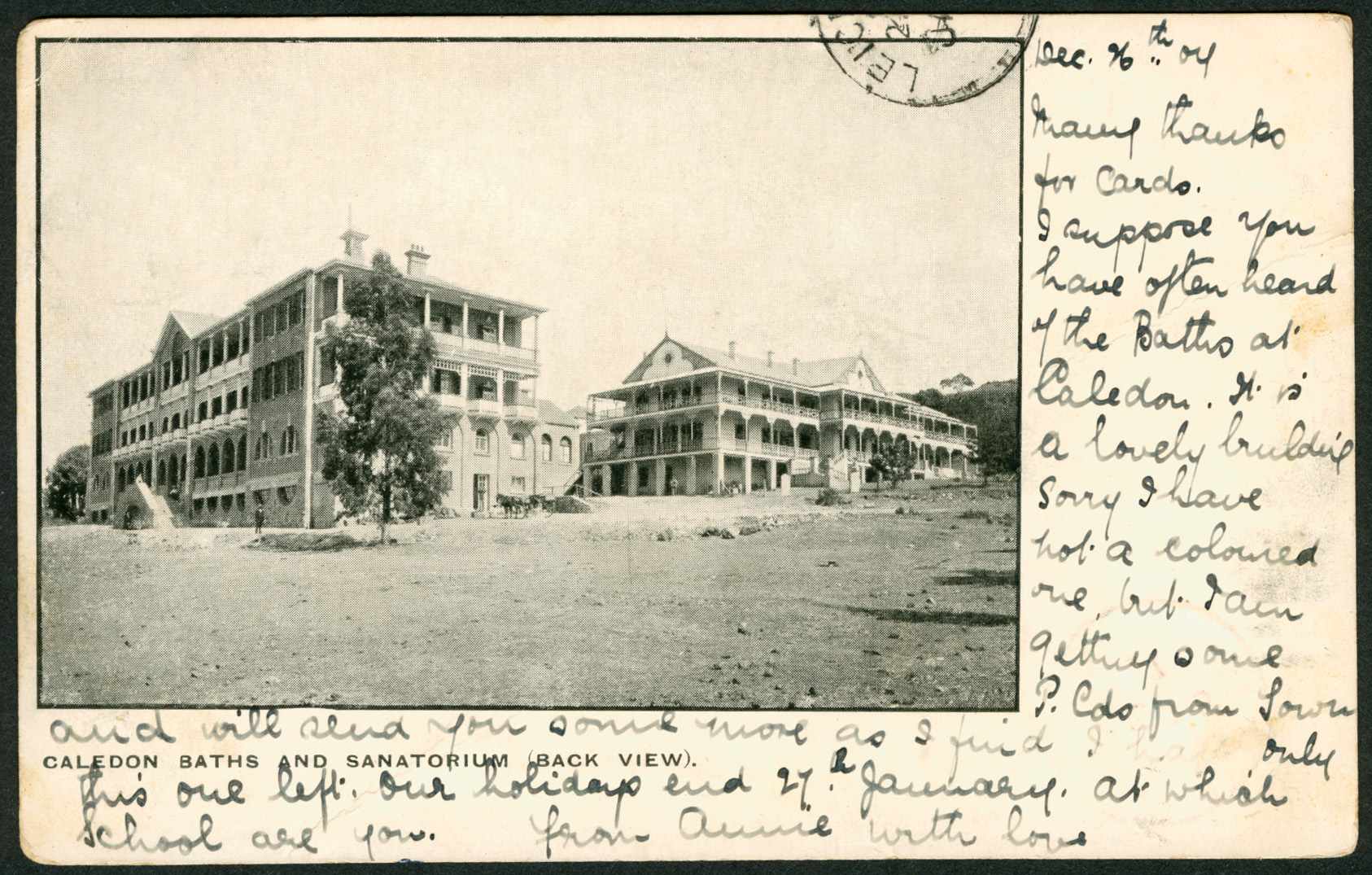
1907. Postcard. NAPIER 'DE 26 07' to LEICESTER, GB 'JA XX 08'. (Caledon Baths and Sanitorium - Back View).
This postcard was presumably supplied by the Proprietors of the Sanitorium.
It is an impressive complex for its time given the rural backwater that it exists in.
"I suppose you have often heard of the baths at Caldon. It is a lovely building!"
This postcard was written on Boxing Day 1907 and posted on the same day in Napier. As there was no railway line connecting Caledon to Napier in 1907, it is likely that the writer was holidaying in Napier some 35 km from Caledon, presumably too far for a round day trip in a horse and cart, one of which can be seen in the postcard above.
Quote from Steve on July 21, 2025, 5:35 pmHermanus Sanitorium and Marine Hotel
HERMANUS PETRUSFONTEIN: 1881 - 1902. (Head Office: Caledon.)
These are reproduced examples of the original town name postmarks.
1901. Cover. HERMANUS PETRUS FONTEIN 'OC 16 01' to CAPE TOWN.
Opened Under Martial Law Censor label and initialled Passed Press Censor cachet.
The Luyts were an established family in Hermanus long before the arrival of 'P John' Luyt in 1903 .The Sanatorium was built in 1896 when the town was known as 'Hermanus Petrusfontein'. This was shortened to 'Hermanus' in 1903. Anglophone Britain had just won the SAW (1899 - 1902) and the Afrikaners weres being given short shrift. Whatever the reasons - English prejudice or a name too long for practical official use - the town became 'Hermanus'. All subsequent postmarks use this name.
The Sanatorium's owner, Dr Hoffman, was married to Maria Smuts, the sister of General Jan Smuts. Apparently General Smuts was a frequent visitor to the Sanatorium. Legend has it that would take an early morning dip in Fick's Pool before walking up the surrounding mountain. (Ficks pool faces west, the Marine pool south.) The Sanitorium became the Windsor Hotel in 1931. My pals and I stayed in its Annex in the winter of 1967. What a time! I almost lost my virginity, the reason for visiting Hermanus!
1912. Postcard. Unused. 'Sanitorium Hermanus'.
The town has by now dropped 'Petrusfontein' from its name.
One of several 'Fonteins' seeps into the sea over the rock cliff ledge seen left.The Marine Hotel below was built by Valentine Beyers and Walter McFarlane in 1902. The consumate hotelier, Pieter Johannes Luyt (fondly known as 'P John', born in Cape Town in 1876, came to Hermanus in 1903 to help run the Marine Hotel. At this time Hermanus was a small fishing village. After a few years P John bought the hotel from Beyers for £5 000. He would put the place on the map.
Circa 1960. Postcard, Unused. 'Marine Hotel, family cottages and private suites. Hermanus, South Africa'.
The changing cubicles of the Marine Hotel's tidal pool can just be seen bottom left. A coastal path runs right.
Circa 1915. Photo. Bathing in the Marine Hotel's Tidal Pool.
'P John' also bought the Riviera Hotel. By the time he died in 1940, he had largely and single-handedly turned Hermanus into a well-known, prosperous and popular seaside resort famed far and wide for its healthy climate, food and recreational activities, most especially angling. It is said that on the day of his funeral, all the town's businesses closed. His wife Joey sold the Riviera Hotel in 1941 and with her daughters continued to run the Marine, now renamed Luyt’s Marine Hotel until she sold it in 1947.
Hermanus Sanitorium and Marine Hotel
 HERMANUS PETRUSFONTEIN: 1881 - 1902. (Head Office: Caledon.)
HERMANUS PETRUSFONTEIN: 1881 - 1902. (Head Office: Caledon.)
These are reproduced examples of the original town name postmarks.
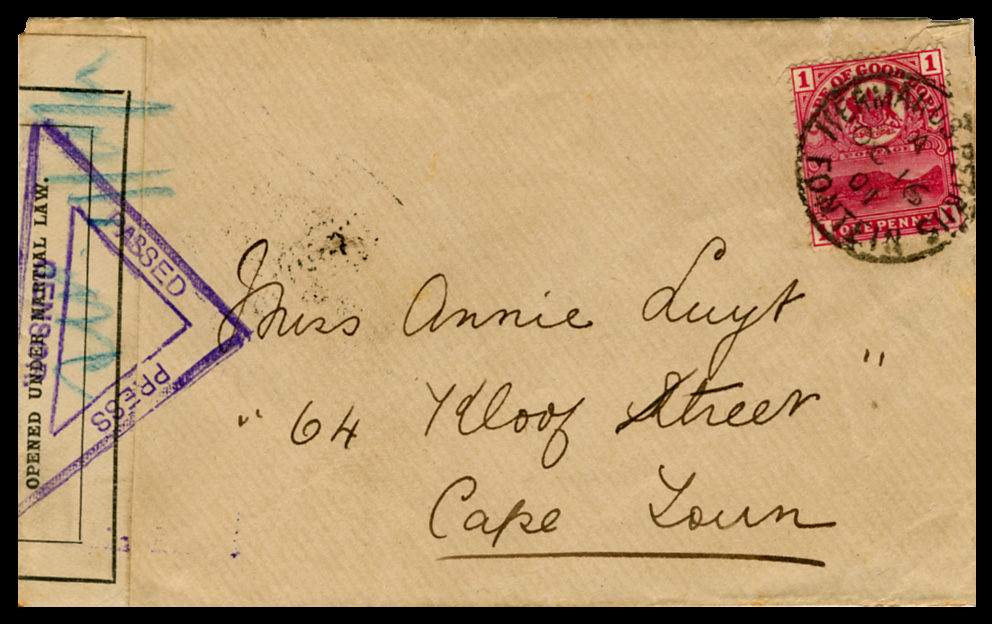
1901. Cover. HERMANUS PETRUS FONTEIN 'OC 16 01' to CAPE TOWN.
Opened Under Martial Law Censor label and initialled Passed Press Censor cachet.
The Luyts were an established family in Hermanus long before the arrival of 'P John' Luyt in 1903 .
The Sanatorium was built in 1896 when the town was known as 'Hermanus Petrusfontein'. This was shortened to 'Hermanus' in 1903. Anglophone Britain had just won the SAW (1899 - 1902) and the Afrikaners weres being given short shrift. Whatever the reasons - English prejudice or a name too long for practical official use - the town became 'Hermanus'. All subsequent postmarks use this name.
The Sanatorium's owner, Dr Hoffman, was married to Maria Smuts, the sister of General Jan Smuts. Apparently General Smuts was a frequent visitor to the Sanatorium. Legend has it that would take an early morning dip in Fick's Pool before walking up the surrounding mountain. (Ficks pool faces west, the Marine pool south.) The Sanitorium became the Windsor Hotel in 1931. My pals and I stayed in its Annex in the winter of 1967. What a time! I almost lost my virginity, the reason for visiting Hermanus!
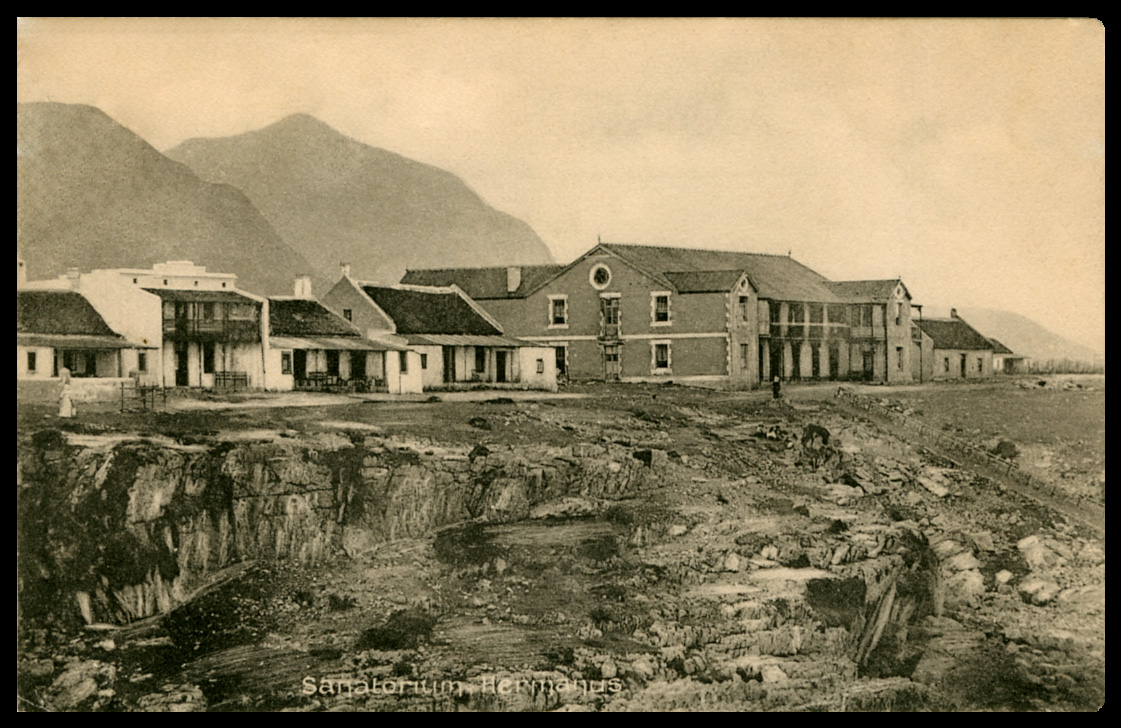
1912. Postcard. Unused. 'Sanitorium Hermanus'.
The town has by now dropped 'Petrusfontein' from its name.
One of several 'Fonteins' seeps into the sea over the rock cliff ledge seen left.
The Marine Hotel below was built by Valentine Beyers and Walter McFarlane in 1902. The consumate hotelier, Pieter Johannes Luyt (fondly known as 'P John', born in Cape Town in 1876, came to Hermanus in 1903 to help run the Marine Hotel. At this time Hermanus was a small fishing village. After a few years P John bought the hotel from Beyers for £5 000. He would put the place on the map.

Circa 1960. Postcard, Unused. 'Marine Hotel, family cottages and private suites. Hermanus, South Africa'.
The changing cubicles of the Marine Hotel's tidal pool can just be seen bottom left. A coastal path runs right.
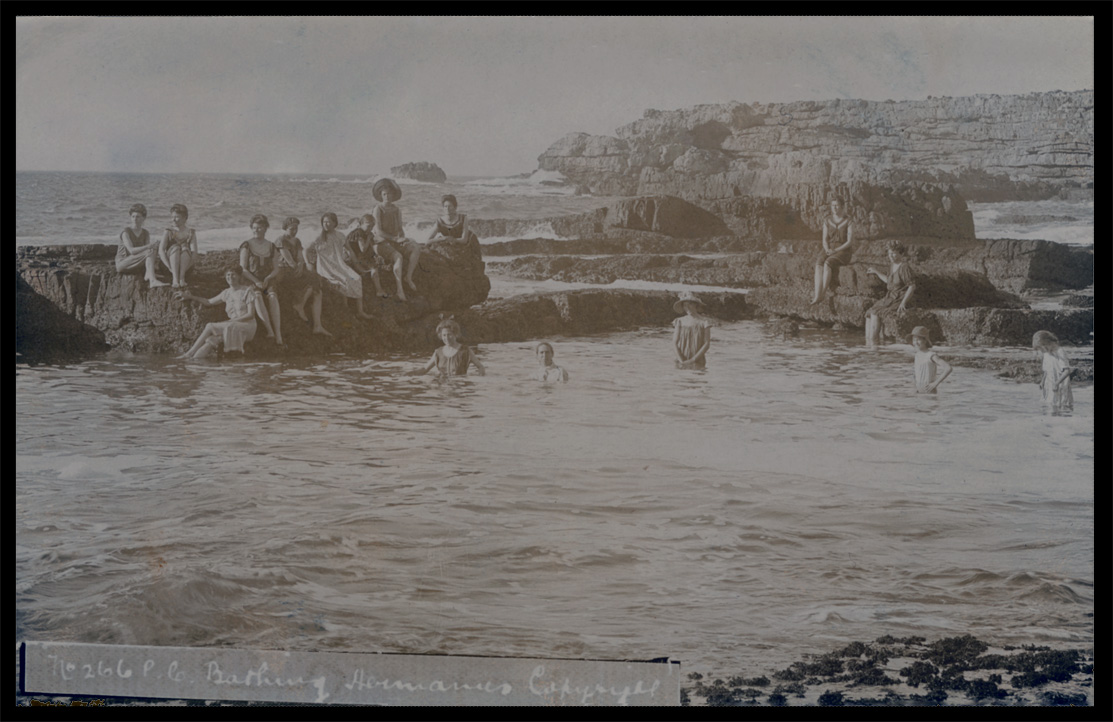
Circa 1915. Photo. Bathing in the Marine Hotel's Tidal Pool.
'P John' also bought the Riviera Hotel. By the time he died in 1940, he had largely and single-handedly turned Hermanus into a well-known, prosperous and popular seaside resort famed far and wide for its healthy climate, food and recreational activities, most especially angling. It is said that on the day of his funeral, all the town's businesses closed. His wife Joey sold the Riviera Hotel in 1941 and with her daughters continued to run the Marine, now renamed Luyt’s Marine Hotel until she sold it in 1947.
